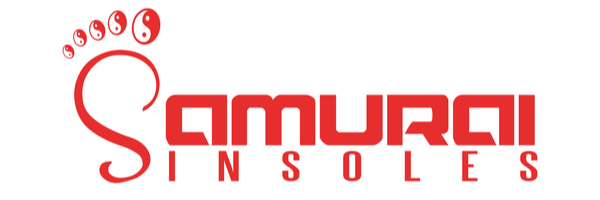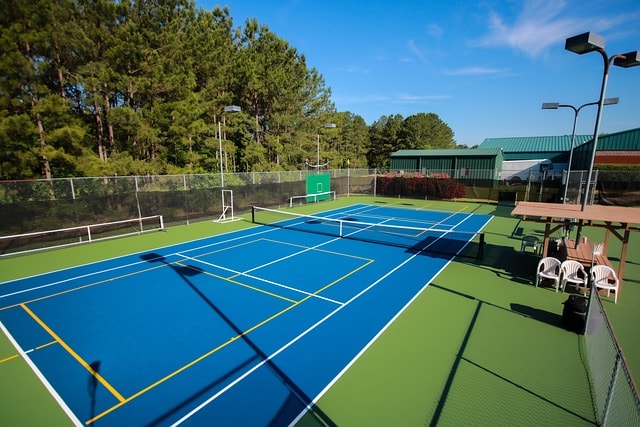Orthotic insoles for fallen arches are specially designed inserts that give your feet the support they're missing. Think of them as a personal support system, helping to bring back your foot's natural shape, ease pain, and make every step feel more stable and secure.
What Are Fallen Arches and How Do Insoles Help?
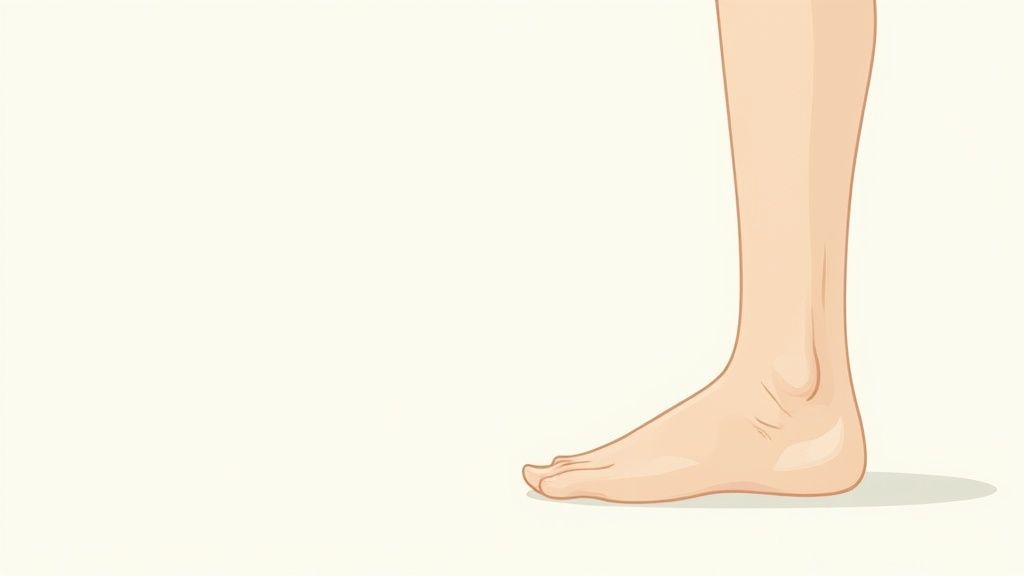
Picture the arch of your foot like the suspension in a car. It’s built to absorb shock, spread your body weight evenly, and give you a spring in your step. But when the tendons and ligaments that form this structure weaken, the arch can collapse or flatten. This common condition is often called "fallen arches" or "flat feet."
When this happens, it's not just a foot problem. A fallen arch often causes the foot to roll too far inward, a motion known as overpronation. This sets off a chain reaction that can travel right up your body, leading to pain in your ankles, knees, hips, and even your lower back. You might feel a dull ache after being on your feet for a while or just feel unsteady when walking.
To give you a quick overview, here's a simple breakdown of what we're talking about:
| Fallen Arches at a Glance | |
|---|---|
| Aspect | Description |
| Common Name | Flat feet, pes planus |
| What Happens | The natural arch of the foot weakens and collapses. |
| Key Issue | Causes overpronation (foot rolls inward). |
| Common Symptoms | Foot pain, ankle instability, knee, hip, and back pain. |
| Insole's Role | To provide external support and correct alignment. |
This table shows just how a simple-sounding issue can have wider effects, and why proper support is so important.
The Role of Orthotic Support
This is exactly where orthotic insoles step in. They act as an external scaffold, doing the job that your weakened arch can't do effectively on its own. By propping up the arch, a good insole achieves a few critical things:
- Restores Proper Alignment: It helps correct overpronation, guiding your foot back into a more natural and balanced position.
- Redistributes Pressure: It takes the strain off your arch and distributes your weight more evenly across the entire sole of your foot.
- Absorbs Shock: It adds a layer of cushioning to soften the impact that travels up your legs every time you take a step.
By creating a firm yet comfortable foundation, orthotic insoles help break the cycle of pain and instability. They don't just put a bandage on the symptoms; they get to the mechanical root of the problem.
And this isn't some rare issue. Studies show that flat feet affect a huge chunk of the population—somewhere between 20% and 37% of people globally. It's one of the main reasons people seek professional help for foot pain.
Learning more about what causes this condition is the first step toward relief. For a deeper dive, you can read our detailed guide on fallen arches symptoms, causes, and treatment options.
Why Do Arches Fall and What Does It Feel Like?
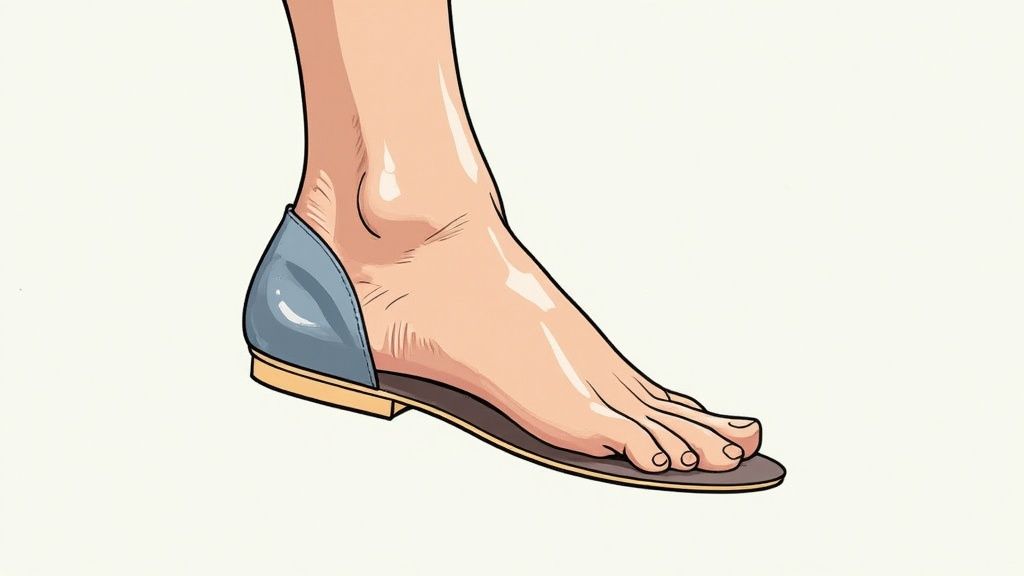
The arches of your feet rarely collapse overnight. It’s usually a gradual process, almost like a slow leak in a tire. The tendons and ligaments that form your foot's supportive scaffolding start to weaken over time, and understanding why is the first step toward getting back on your feet comfortably.
Think of it this way: your posterior tibial tendon, which runs from your calf down to the inside of your foot, is the main support cable holding up your arch. When that tendon gets overworked, stretched out, or inflamed, it can't do its job properly. The result? The arch begins to sag.
This condition, often called posterior tibial tendon dysfunction (PTTD), is a primary cause of adult-acquired flat feet. But what puts that tendon and other support structures under so much strain in the first place? It's typically a combination of things.
Common Triggers for Fallen Arches
The reasons your arches might start to drop are as varied as the people who experience it. Your unique genetics, daily habits, and life events can all put stress on the delicate architecture of your feet.
Here are some of the most common culprits:
- Genetics: Sometimes, it's just in your DNA. You can inherit a tendency for weaker connective tissues or a naturally low arch, just like you inherit your eye color.
- Aging: Simply put, decades of walking, running, and standing take a toll. Over the years, our tendons naturally lose some of their spring and strength.
- Injuries: A bad ankle sprain or a fracture in your foot can directly damage the structures that hold up your arch, sometimes leading to a fairly sudden collapse.
- Lifestyle Factors: Your day-to-day life plays a huge role. Jobs that keep you on your feet all day, significant weight gain, or repetitive high-impact sports all place enormous strain on your arches.
These factors often team up. For instance, if you have a genetic predisposition for flat feet and then take a job working 10-hour shifts on a concrete floor, your risk multiplies. It’s this piling-on effect that usually brings the problem to the surface.
What Fallen Arches Actually Feel Like
It’s one thing to know the causes, but it’s another to recognize the signs in your own body. Fallen arches aren't just a cosmetic issue; they affect how you feel and how your entire body is aligned.
Often, the first sign is a dull, persistent ache in your feet. You might just feel like your feet get tired or sore much faster than they used to, especially after a long day.
The pain from fallen arches rarely stays in the feet. Since your feet are the foundation for your entire body, when they're out of alignment, it creates a chain reaction that travels all the way up your legs to your back.
As the condition develops, the symptoms usually become more specific:
- Aching or Sharp Pain: This is typically felt along the arch and the inside of your ankle.
- Swelling: You might notice some puffiness along the inner ankle, especially after being on your feet.
- Pain in Other Joints: That mysterious knee, hip, or lower back pain might actually be starting in your feet. When your feet don't absorb shock properly, other joints are forced to pick up the slack.
- Feeling Unsteady: Without that natural "spring" in your step from a healthy arch, you might feel less stable or balanced.
Catching these signs early is key. It's your body's way of telling you that its foundation needs help. This is where orthotic insoles for fallen arches can make a world of difference, providing the support you need to restore balance from the ground up.
What Supporting Your Fallen Arches Actually Does for You

When you use orthotic insoles for fallen arches, you're doing a lot more than just quieting down some foot pain. Think of it as a positive ripple effect starting right where your shoe meets the ground, working its way up to bring your whole body back into balance. It’s not just about comfort—it's about getting your body to function the way it was meant to.
When your arches collapse, your feet often roll too far inward. This is a common problem called overpronation, and it throws your entire alignment out of whack, forcing other joints to pick up the slack. A good insole is like a skilled mechanic for your body, shoring up the foundation so the whole structure can stand tall and strong.
And this isn't a rare issue. Far from it. Research shows that flat feet affect a huge chunk of the population, with one study finding it in 26.62% of adults. For some, like people with diabetes, that number can shoot up to 37%. These stats really drive home how vital proper foot support is for keeping pain at bay and staying active. If you want to dive deeper, you can read more about the study on flatfoot prevalence and see the full picture.
Creating a Chain of Positive Effects
By giving your arches the targeted support they need, orthotic insoles kick off a cascade of benefits that you’ll feel well beyond your feet. It's a chain reaction of relief and stability that makes a real difference in your day-to-day life.
The most immediate improvements usually include:
- Better Ankle Stability: By correcting that inward roll (overpronation), insoles help stabilize your ankles, which can cut down on sprains and that wobbly feeling.
- Less Strain on Knees and Hips: When your feet are properly aligned, your knees and hips don't have to twist unnaturally to absorb impact. The result? Less joint pain.
- Easing Lower Back Pain: A solid foundation in your feet helps align your entire body. This often eases the chronic lower back pain that so many people don't realize starts with their feet.
This improved alignment simply means less muscle fatigue at the end of the day. All of a sudden, a long day of walking around or working on your feet doesn't have to end with you gritting your teeth through the pain.
The real magic of orthotic insoles is how they transform daily activities. What was once painful becomes manageable, and what was once manageable becomes enjoyable. You can focus on your life, not your feet.
Preventing Problems Down the Road
Beyond the immediate relief, supporting fallen arches is one of the smartest preventative moves you can make for your body. An unsupported flat foot is a magnet for a host of other painful conditions that can easily sideline you from the things you love to do.
By wearing orthotic insoles for fallen arches, you are actively lowering your risk of developing related issues like:
- Plantar Fasciitis: This all-too-common cause of stabbing heel pain is often directly linked to the strain from collapsed arches.
- Shin Splints: When your feet overpronate, the muscles in your lower legs have to work overtime to stabilize your stride, leading to that familiar searing pain along your shin.
- Achilles Tendonitis: Poor alignment puts extra stress on your Achilles tendon, which can lead to painful inflammation over time.
This proactive approach doesn’t just help with the pain you feel now; it safeguards your mobility for the future. If that inward foot roll is a particular struggle, you might find our guide on orthotics for foot pronation helpful. Supporting your arches today is a true investment in healthier, pain-free movement for years to come.
How to Choose the Right Orthotic Insoles
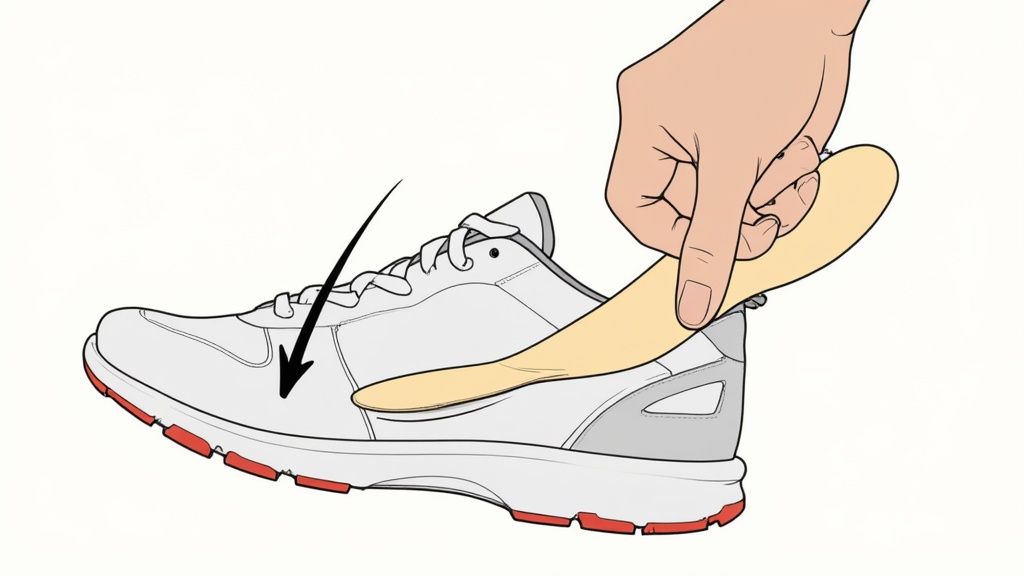
Feeling a bit overwhelmed by all the insole options out there? You're definitely not alone. It can seem complicated, but picking the right orthotic insoles for your fallen arches is actually pretty straightforward once you know what to look for. The secret is matching the insole’s features to your specific needs, the shape of your foot, and your daily life.
Think about it like this: you wouldn't use a delicate teacup to haul heavy bricks. In the same way, the right insole gives you the correct level of support for the job at hand. This decision really boils down to two main things: the type of support and the material used to make the insole.
Matching Support Type to Your Needs
The level of support is the most critical factor here. It's what determines how well the insole can correct your alignment and spread out the pressure on your feet. Generally, over-the-counter insoles fall into one of three camps, each designed for a different purpose.
To make things easier, here’s a quick comparison of the main types of orthotic support you’ll find. This should help you figure out which one fits your situation best.
Comparing Insole Support Types
| Support Type | Best For | Key Feature |
|---|---|---|
| Rigid Support | Severe overpronation and significant instability. | Offers maximum motion control and structural support, acting like a firm foundation to realign your foot. |
| Semi-Rigid Support | Moderate fallen arches and daily activities. | Provides a balance of firm support and flexible comfort, guiding your foot without feeling overly stiff. |
| Soft/Cushioned Support | Mild discomfort and shock absorption. | Focuses on providing a plush, protective layer to absorb impact, but offers minimal structural arch correction. |
For most people dealing with fallen arches, semi-rigid support is the sweet spot. It’s firm enough to properly lift the arch and fix your alignment, but it also has enough flex to keep you comfortable through a long day on your feet.
Understanding Insole Materials
The material an insole is made from plays a huge role in its durability, comfort, and how well it works. The most common options you'll come across are foam, gel, and cork, and each has its own strengths depending on what your day looks like.
Here’s a quick guide to what these materials bring to the table:
- Foam: Lightweight and incredibly versatile, foam gives you a great mix of cushioning and support. High-density foams are perfect for durable, everyday insoles that need to strike that balance between comfort and structure.
- Gel: Famous for its amazing shock absorption, gel inserts are a fantastic choice for high-impact activities or for anyone who spends their day standing on hard floors. They deliver targeted comfort but usually offer less in the way of true arch support.
- Cork: This natural material is pretty neat because it gradually molds to your foot, creating a custom fit over time. It's firm and supportive, making it a solid option for those who need both stability and a personalized shape.
The goal is to find an insole that addresses the root cause of your pain—the collapsed arch—without creating new discomfort. The ideal orthotic insoles for fallen arches will feel supportive, not intrusive.
Choosing the right insert involves a little more than just grabbing one off the shelf. For a more detailed walkthrough of what to consider, take a look at our guide on how to choose shoe inserts. It’s packed with even more tips to help you make a confident choice and find lasting relief.
So, Why Are Samurai Insoles a Smarter Choice?
If you've ever tried to find the right orthotic insole for your fallen arches, you know it can feel like a frustrating game of trial and error. So many options on the market fall into one of two traps: they're either rock-hard and bulky, forcing your foot into an awkward, unnatural position, or they're so soft and flimsy they might as well be a piece of foam.
This is where Samurai Insoles really stand out. They were created by a podiatrist who took a completely different, biomedical approach.
Instead of just propping up the foot with brute force, these insoles are designed to give you firm, springy support right where your arch needs it most. It’s a targeted lift, not an aggressive push, and it avoids that bulky, intrusive feeling you get from a lot of other orthotics. That design philosophy makes all the difference.
Designed for Your Real Life, Not Just Special Shoes
One of the biggest headaches with traditional orthotics is their sheer size. You often have to buy new shoes a size up just to cram them in, and forget about trying to fit them into sleek dress shoes or your favorite low-profile sneakers. Samurai Insoles were built to solve this exact problem with an intentionally lightweight, slim design.
Because they’re so streamlined, they can slip easily into almost any shoe you own. You can either replace the flimsy factory insole or, in many cases, just place them right on top. This means you get the same reliable support whether you're in the office, at the gym, or just out for a walk. You finally don't have to choose between the shoes you love and the support your feet desperately need.
The best orthotic is the one you’ll actually wear every day. Samurai Insoles are designed to integrate seamlessly into your life, providing a comfortable foundation that makes you forget you’re even wearing them.
This focus on everyday comfort is so important, especially when you consider how common flat feet are. Research shows that symptomatic flatfoot is a significant issue for many adults, impacting mobility and overall quality of life. It often stems from childhood, where prevalence rates can be as high as 30%. You can read the full research on flatfoot prevalence to get a better sense of its widespread impact.
What This Actually Means for Your Feet
All this thoughtful engineering sounds great, but what does it actually feel like? It all comes down to real-world benefits you'll notice from day one.
- Targeted Arch Support: The molded inner shell acts like a spring, giving your arch a dynamic lift. This helps realign your foot and takes the strain off your posterior tibial tendon, which is often the source of the pain.
- Feather-Light Construction: You get serious, medical-grade support without any of the clunky weight that causes your feet to feel tired and heavy by the end of the day.
- Unmatched Versatility: Their slim profile gives you consistent relief no matter what you're wearing, from your running shoes to your casual loafers.
When it comes down to it, Samurai Insoles strike that perfect balance between solid biomechanical support and discreet, all-day comfort. They offer a practical and effective way for anyone to get reliable, daily relief from the pain and instability that fallen arches can cause.
Your Questions About Orthotics Answered
Deciding to try orthotic insoles for your fallen arches is a fantastic first step. But once you have them in hand, a whole new set of practical questions usually pops up. That's perfectly normal. Let's walk through some of the common things people wonder about so you can feel confident and get the relief you're looking for.
Is There a Break-In Period?
Yes, there is, and you should expect it. Think of it like breaking in a new pair of high-quality leather boots. Your feet have gotten used to a certain (less than ideal) way of functioning, and now you're introducing them to a new, healthier alignment. They need a little time to adapt.
I always recommend easing into it. Start by wearing your new orthotics for just an hour or two on the first day. From there, you can slowly add another hour of wear each day. For most people, it takes about 7 to 14 days to feel completely comfortable. This gradual approach is the best way to avoid any initial discomfort as your foot muscles get used to the new support.
How Long Will My Insoles Last?
This really depends on how active you are and how often you're wearing them. If you’re using them every day for your work shoes or for regular walking, a good pair of insoles should last you somewhere between 6 to 12 months.
A good rule of thumb is to simply pay attention to your insoles and your feet. If you can see that the arch support looks compressed or flattened, or you start to feel those old familiar aches creeping back in, it’s a sure sign that it's time for a replacement.
Can I Move Them Between Different Shoes?
Absolutely! This is one of the best things about a well-designed, low-profile orthotic. You should be able to slip them out of your work shoes and into your running sneakers or casual weekend shoes without any hassle. This way, you get consistent support all day long, no matter what's on your schedule.
Having a versatile insole means you don't have to choose between wearing the shoes you like and taking care of your feet. And to keep them in good shape, just wipe them down with a damp cloth and a little mild soap, then let them air dry. It’s that easy.
Ready to find the support your feet have been missing? Samurai Insoles are biomechanically engineered to provide targeted relief for fallen arches without the bulk. Discover a smarter way to stay comfortable and active by exploring our collection of Samurai Insoles.
